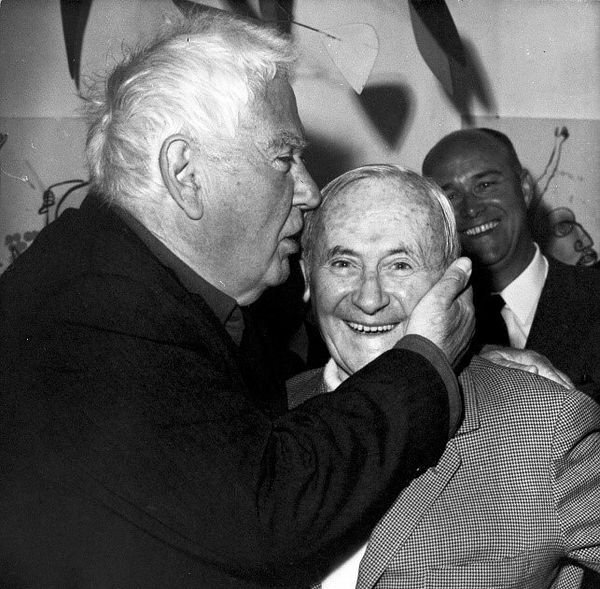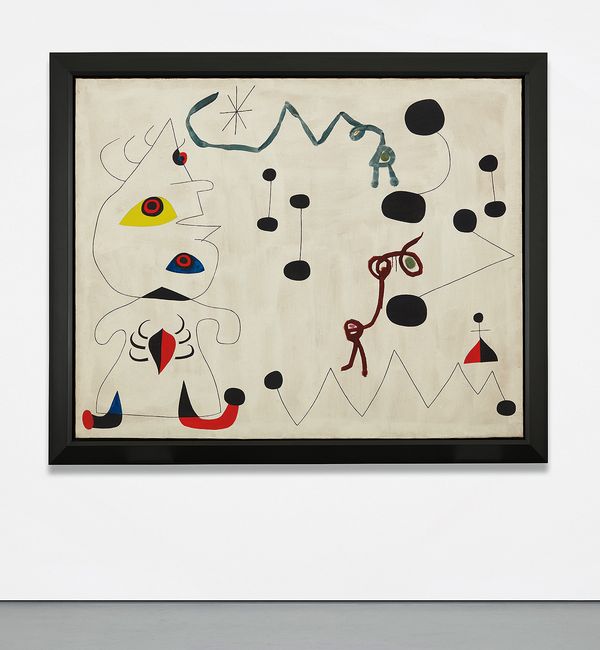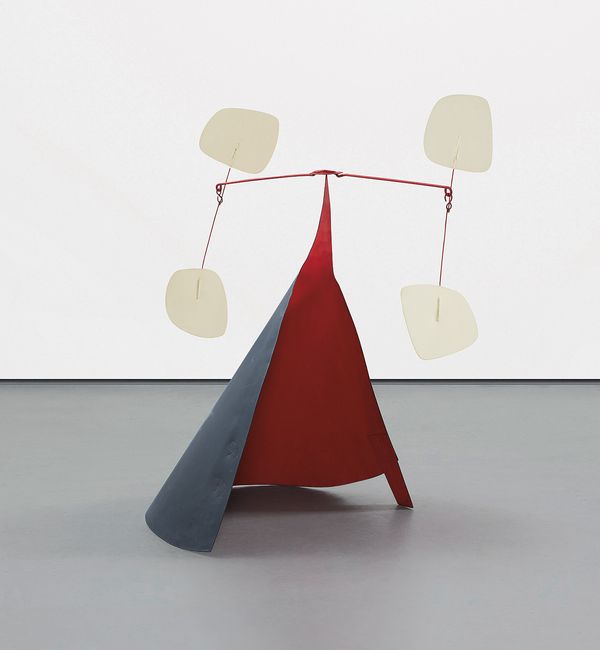Alexander Calder (left) and Joan Miró (right)
Few artists have shaped the scope of art in the 20th century as much as Joan Miró and Alexander Calder. Their remarkably similar artistic sensibilities revolutionized their respective mediums of painting and sculpture. Though emerging in very different contexts — Miró was born in Barcelona in 1893, Calder in Lawnton, Pennsylvania in 1898 — the two artists forged an intense and lasting friendship after first meeting in interwar Paris in 1928. Even after Calder returned to the United States and World War II splintered their communication, they remained deeply engaged with each other's artistic developments until Calder's death in 1976.
Sandy, the man, the friend, has a heart as big as Niagara. Calder, the artist, has the force of the ocean. I salute you, Sandy.
— Joan Miró
Sharing a similar vision and fascination with cosmological relationships, the two artists purged the last remnants of illusionism from their respective mediums by taking line and color into previously uncharted territories. While separated by nearly three decades, Miró's Femme dans la nuit, 1945, and Calder's Conique noir, 1973, reveal the intriguing parallels between these two titans of modern art.
Joan Miró Femme dans la nuit, 1945
Painted on March 22, 1945, Femme dans la nuit forms part of the ambitious series of fourteen so-called "white-ground" paintings that Miró undertook between 26 January and 7 May 1945. Miró embarked upon this series while living and working in relative isolation in Spain, having narrowly escaped France shortly after it was invaded in 1940. When Miró undertook this epic cycle of works, he did so with the belief that these would become his magnum opus. An heir to his celebrated Constellations, these paintings formed his most ambitious body of work since the onset of World War II.
While light and optimism were tentatively raising their heads in 1945 — France had been liberated in the summer of 1944 — there was nonetheless a keen awareness of the toll of war. In Femme dans la nuit, this is made vivid by the presence of a sky laden with weighty forms; in many ways, the woman can be seen as an analogue for the screaming and wailing figures of Pablo Picasso's Guernica.
Alexander Calder Conique noir, 1973
With its organic shapes and whimsical lines, Calder's Conique noir appears like the sculptural realization of the organic forms teeming in Miró's compositions. While the sight of seeing Piet Mondrian's unframed canvases in the late 1920s had inspired Calder to begin his own experiments of abstraction, it was perhaps above all his dialogue with Miró that had helped him elaborate and develop his trailblazing ideas concerning balance and motion over the years.
Both Miró and Calder showed at the Pierre Matisse Gallery in the 1930s, and it is telling that when Calder's mobiles were exhibited at his second show there in 1936, critics were quick to point out the parallels to Miró's art: "They are very much like Miró abstractions come to life," wrote Emily Genauer for New York World-Telegram in February 1936.
Well, the archaeologist will tell you there's a little bit of Miró in Calder and a little bit of Calder in Miró.
— Alexander Calder
Building on a lifetime of innovation, Calder created Conique noir three years before he would pass away. Fusing his iconic sculptural archetypes of the stabile and the mobile into a singular, impeccably balanced work, Calder revisited the conical shape of one of his earliest mobiles, Cône d'ébène, 1933. The conical shape is a rare form to occur in Calder's oeuvre, here updated within the context of the Space Age. Like Calder's Obus, 1972, National Gallery of Art, Washington D.C., which presented the rough shape of a rocket launcher with fire-engine red flames spurting from its side, Conique noir, too, gives rise to an unadulterated sense of upward movement.
Miró's Femme dans la nuit and Calder’s Conique noir form highlights of our upcoming 20th Century & Contemporary Evening Sale on 15 November and are currently on view at 450 Park Avenue.


